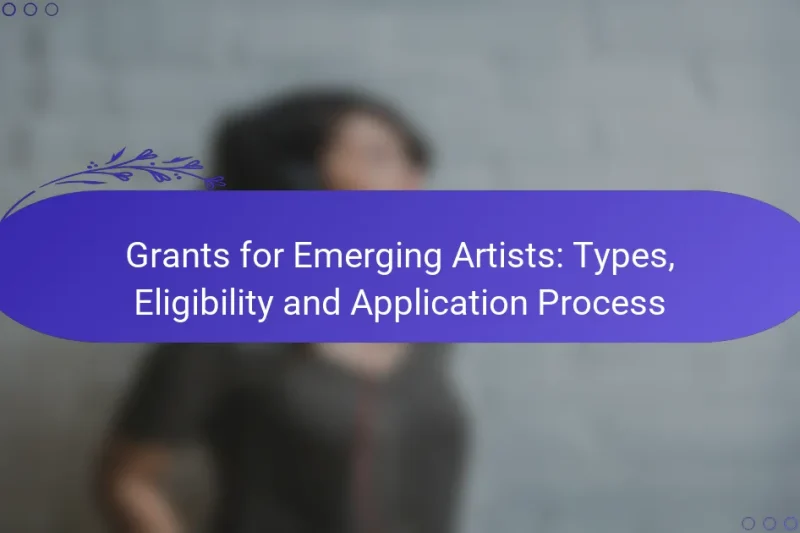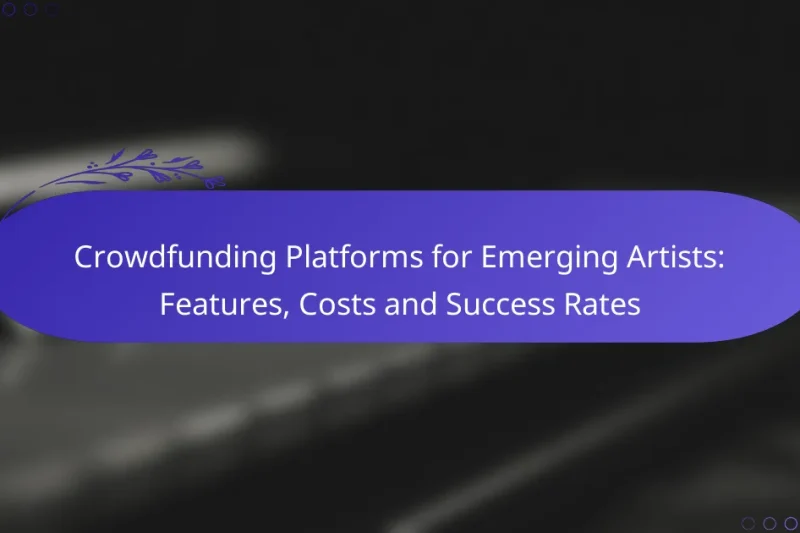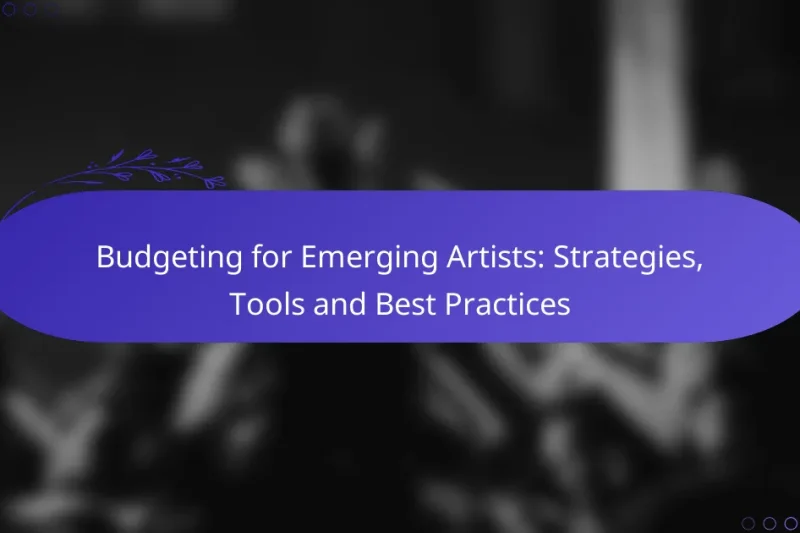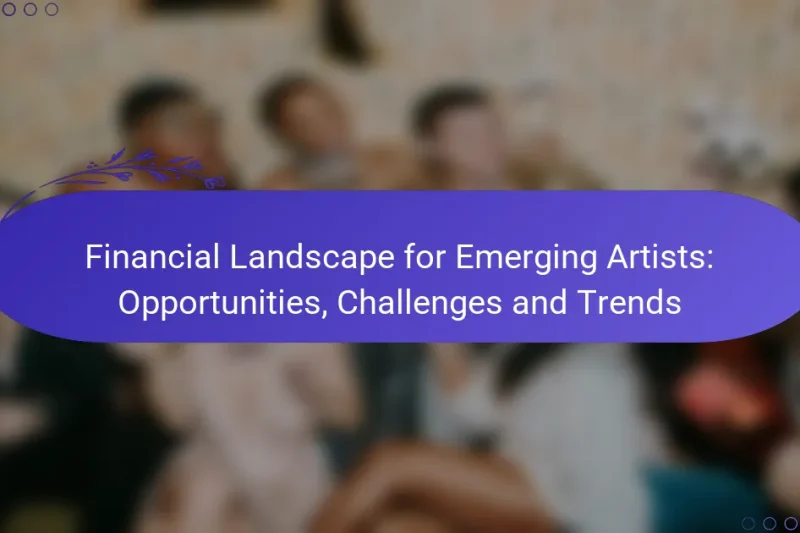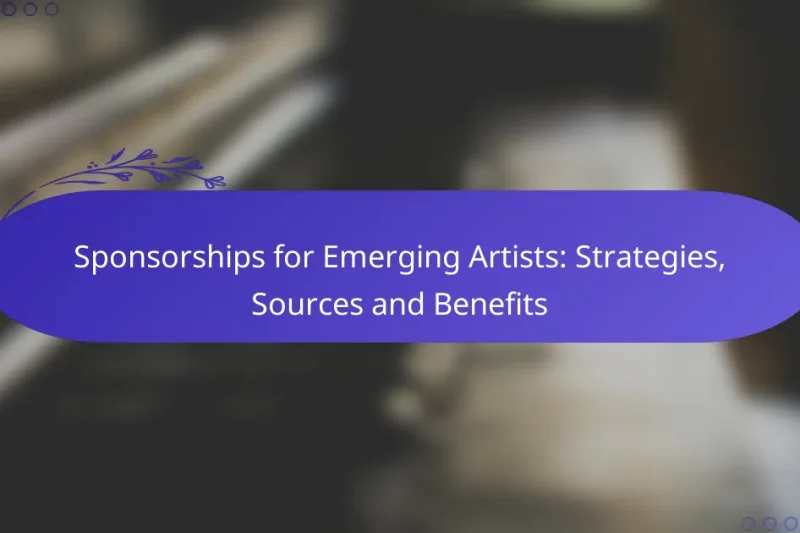Nonprofits play a vital role in nurturing emerging artists by offering essential resources, mentorship, and funding … Nonprofits Supporting Emerging Artists: Roles, Programs and ImpactRead more
Emerging Artist Spotlights: Funding and Grants
Emerging artists in the US have access to a variety of funding options, including grants from government bodies, private foundations, and crowdfunding platforms. These financial resources are vital for artists looking to develop their work and enhance their visibility in the competitive art landscape.
Grants for Emerging Artists: Types, Eligibility and Application Process
Emerging artists in the US have access to a variety of grants designed to support their … Grants for Emerging Artists: Types, Eligibility and Application ProcessRead more
Crowdfunding Platforms for Emerging Artists: Features, Costs and Success Rates
Crowdfunding platforms provide emerging artists with essential tools to finance their creative projects. By focusing on … Crowdfunding Platforms for Emerging Artists: Features, Costs and Success RatesRead more
Budgeting for Emerging Artists: Strategies, Tools and Best Practices
Budgeting is crucial for emerging artists seeking to balance their creative pursuits with financial stability. By … Budgeting for Emerging Artists: Strategies, Tools and Best PracticesRead more
Funding Applications for Emerging Artists: Steps, Tips and Resources
Funding applications are crucial for emerging artists seeking financial support for their creative projects. By exploring … Funding Applications for Emerging Artists: Steps, Tips and ResourcesRead more
Financial Landscape for Emerging Artists: Opportunities, Challenges and Trends
The financial landscape for emerging artists is filled with both opportunities and challenges that can shape … Financial Landscape for Emerging Artists: Opportunities, Challenges and TrendsRead more
Sponsorships for Emerging Artists: Strategies, Sources and Benefits
Sponsorships play a crucial role in the development of emerging artists by providing essential financial support … Sponsorships for Emerging Artists: Strategies, Sources and BenefitsRead more
What funding options are available for emerging artists in the US?
Emerging artists in the US have various funding options, including grants from government bodies, private foundations, and crowdfunding platforms. These resources can provide essential financial support to help artists develop their work and gain visibility.
National Endowment for the Arts grants
The National Endowment for the Arts (NEA) offers grants specifically designed to support artists and arts organizations. These grants typically fund projects that enhance community engagement and cultural development.
To apply, artists must submit a proposal detailing their project, budget, and expected outcomes. Grants can range from a few thousand to hundreds of thousands of dollars, depending on the project’s scope and impact.
Artist Relief Grants
Artist Relief Grants provide direct financial assistance to artists facing economic hardships due to unforeseen circumstances, such as the COVID-19 pandemic. These grants aim to alleviate immediate financial stress and support artists’ continued work.
Eligible artists can apply for a one-time grant, typically in the range of $5,000. The application process is straightforward, requiring personal information and a brief description of the artist’s situation and work.
Local arts council funding
Local arts councils often provide funding opportunities tailored to regional artists. These grants can support specific projects, exhibitions, or community-based initiatives that promote local culture.
Artists should check with their local arts council for specific eligibility criteria and application deadlines. Funding amounts vary widely, but local councils typically offer smaller grants, often ranging from $500 to $10,000.
Private foundation grants
Many private foundations offer grants to emerging artists, focusing on specific disciplines or community engagement. These foundations often have unique missions and funding priorities, making it essential for artists to research which foundations align with their work.
Grants from private foundations can range from a few thousand dollars to substantial sums, depending on the foundation’s resources and goals. Artists should prepare a compelling proposal that aligns with the foundation’s mission to increase their chances of success.
Crowdfunding platforms
Crowdfunding platforms like Kickstarter and Indiegogo allow artists to raise funds directly from their supporters. This method can be particularly effective for specific projects, such as album releases or art installations.
Artists should create a clear campaign that outlines their goals, budget, and rewards for backers. Successful campaigns often feature engaging visuals and a strong narrative, and funding amounts can vary widely, from a few hundred to tens of thousands of dollars, depending on the project’s appeal and outreach efforts.
How can emerging artists apply for grants?
Emerging artists can apply for grants by identifying suitable funding opportunities, preparing their applications, and submitting them according to specific guidelines. Each grant may have unique requirements, so understanding the application process is crucial for success.
Step-by-step application process
The application process typically begins with research to find grants that align with the artist’s work and goals. Once suitable grants are identified, artists should carefully read the eligibility criteria and guidelines provided by the funding organization.
Next, artists should prepare their application materials, which often include a project proposal, budget, and artist statement. After compiling these documents, applicants can submit their applications through the designated platform, ensuring they meet all deadlines.
Required documentation
Most grant applications require specific documentation to support the proposal. Commonly needed items include a detailed project description, a budget outline, and a resume or CV highlighting the artist’s background and achievements.
Some grants may also ask for work samples, references, or letters of support. It’s essential to check each grant’s requirements carefully to ensure all necessary documentation is included to avoid disqualification.
Common application pitfalls
One common pitfall is failing to follow the grant guidelines precisely, which can lead to automatic disqualification. Artists should pay close attention to formatting, word limits, and submission methods.
Another issue is not providing sufficient detail in the project proposal or budget, making it difficult for reviewers to understand the project’s scope and feasibility. Artists should aim for clarity and thoroughness in their applications to enhance their chances of success.
What are the eligibility criteria for artist grants?
Eligibility criteria for artist grants typically include residency requirements, artistic discipline specifications, and income limits. Understanding these criteria is essential for artists seeking funding opportunities.
Residency requirements
Many artist grants require applicants to be residents of a specific country or region. This can mean living in the area for a certain period or having a permanent address there. For example, some grants in the United States may prioritize artists who have lived in the state where the funding is offered.
Additionally, certain grants may have residency requirements that specify whether applicants must be citizens, permanent residents, or temporary residents. It’s crucial to review these details carefully to ensure eligibility.
Artistic discipline specifications
Artist grants often focus on specific artistic disciplines, such as visual arts, music, theater, or literature. Each grant may specify which disciplines are eligible, so artists should align their applications with these categories. For instance, a grant might only support contemporary visual artists, excluding other forms of art.
Some grants may also encourage interdisciplinary projects, allowing artists to collaborate across different fields. Understanding the focus of each grant can help artists tailor their proposals effectively.
Income limits
Many grants impose income limits to ensure funding supports artists who may be financially disadvantaged. These limits can vary widely, often ranging from a few thousand to tens of thousands of dollars in annual income. Artists should check the specific income thresholds for each grant they are considering.
It’s important to note that some grants may require applicants to provide proof of income or financial need. Artists should prepare necessary documentation, such as tax returns or financial statements, to demonstrate their eligibility.
What are the benefits of receiving funding for emerging artists?
Receiving funding can significantly enhance the opportunities available to emerging artists, providing essential resources for creative projects, increasing their visibility, and facilitating valuable connections within the industry. Grants and funding can help artists focus on their work without the burden of financial constraints.
Financial support for projects
Financial support allows emerging artists to invest in their creative projects, covering costs such as materials, studio space, and production expenses. This funding can range from a few hundred to several thousand dollars, depending on the grant or funding source.
Artists should carefully review the eligibility criteria and application processes for various funding opportunities, as some may require detailed project proposals or budgets. Securing funding can enable artists to take on larger, more ambitious projects that may not have been feasible otherwise.
Increased visibility and exposure
Funding often comes with promotional benefits, helping artists gain visibility through exhibitions, showcases, or online platforms. Grants may include marketing support, which can amplify an artist’s reach and introduce their work to new audiences.
Participating in funded projects can also lead to features in art publications or social media, enhancing an artist’s profile. This increased exposure can attract further opportunities, including sales, commissions, or collaborations.
Networking opportunities
Funding programs frequently provide networking opportunities with other artists, industry professionals, and potential mentors. These connections can lead to collaborations, exhibitions, and even job offers, helping artists build a supportive community.
Engaging with fellow funded artists can foster creative exchange and inspire new ideas. Attending workshops, seminars, or events associated with funding can also enhance an artist’s skills and knowledge, furthering their career development.
What are the challenges in securing funding for artists?
Securing funding for artists presents several challenges, including high competition, complex application processes, and limited availability of funds. These obstacles can make it difficult for emerging artists to access the financial support they need to develop their work and careers.
High competition for grants
The competition for grants is intense, with numerous artists vying for a limited number of funding opportunities. Many grant programs receive hundreds or even thousands of applications, making it essential for artists to stand out with a compelling proposal. Tailoring applications to align closely with the funder’s mission can increase chances of success.
Emerging artists should research specific grants that cater to their medium or artistic focus, as niche opportunities may have less competition. Networking with other artists and attending workshops can also provide insights into successful application strategies.
Complex application processes
Many funding applications require detailed documentation, including project proposals, budgets, and timelines. This complexity can be daunting, especially for artists who may not have experience with grant writing. It’s crucial to carefully read the guidelines and follow them precisely to avoid disqualification.
Artists can benefit from seeking assistance through workshops or mentorship programs that focus on grant writing. Creating a checklist of required materials and deadlines can help streamline the process and ensure that nothing is overlooked.
Limited funding availability
Funding availability for artists can be quite limited, particularly in certain regions or for specific art forms. Many grants are funded by government agencies, private foundations, or corporate sponsors, each with their own priorities and restrictions. This can lead to a scarcity of resources for emerging artists.
To navigate this landscape, artists should diversify their funding sources by applying for multiple grants and exploring alternative options such as crowdfunding or sponsorships. Staying informed about new funding opportunities and deadlines can also enhance their chances of securing financial support.

